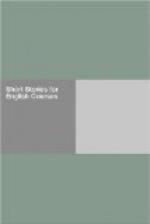“The ‘good glass,’ I knew, could have reference to nothing but a telescope; for the word ‘glass’ is rarely employed in any other sense by seamen. Now here, I at once saw, was a telescope to be used, and a definite point of view, admitting no variation, from which to use it. Nor did I hesitate to believe that the phrases, ‘twenty-one degrees and thirteen minutes,’ and ’north-east and by north,’ were intended as directions for the levelling of the glass. Greatly excited by these discoveries, I hurried home, procured a telescope, and returned to the rock.
“I let myself down the ledge, and found that it was impossible to retain a seat on it unless in one particular position. This fact confirmed my preconceived idea. I proceeded to use the glass. Of course, the ‘twenty-one degrees and thirteen minutes’ could allude to nothing but elevation above the visible horizon, since the horizontal direction was clearly indicated by the words, ’north-east and by north.’ This latter direction I at once established by means of a pocket-compass; then, pointing the glass as nearly at an angle of twenty-one degrees of elevation as I could do it by guess, I moved it cautiously up or down, until my attention was arrested by a circular rift or opening in the foliage of a large tree that overtopped its fellows in the distance. In the centre of this rift I perceived a white spot, but could not, at first, distinguish what it was. Adjusting the focus of the telescope, I again looked, and now made it out to be a human skull.
“On this discovery I was so sanguine as to consider the enigma solved; for the phrase ‘main branch, seventh limb, east side,’ could refer only to the position of the skull on the tree, while ‘shoot from the left eye of the death’s-head’ admitted, also, of but one interpretation, in regard to a search for buried treasure. I perceived that the design was to drop a bullet from the left eye of the skull, and that a bee-line, or, in other words, a straight line, drawn from the nearest point of the trunk through ‘the shot’ (or the spot where the bullet fell), and thence extended to a distance of fifty feet, would indicate a definite point—and beneath this point I thought it at least possible that a deposit of value lay concealed.”
“All this,” I said, “is exceedingly clear, and, although ingenious, still simple and explicit. When you left the Bishop’s Hotel, what then?”
“Why, having carefully taken the bearings of the tree, I turned homewards. The instant that I left ‘the devil’s seat,’ however, the circular rift vanished; nor could I get a glimpse of it afterwards, turn as I would. What seems to me the chief ingenuity in this whole business, is the fact (for repeated experiment has convinced me it is a fact) that the circular opening in question is visible from no other attainable point of view than that afforded by the narrow ledge on the face of the rock.




